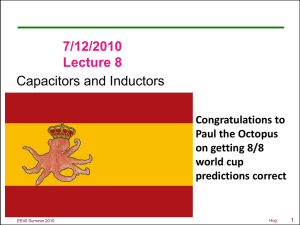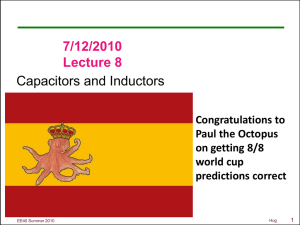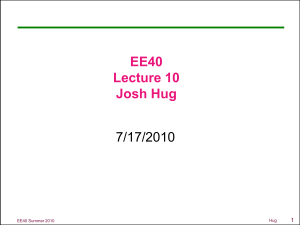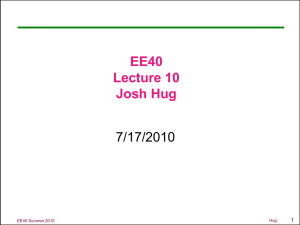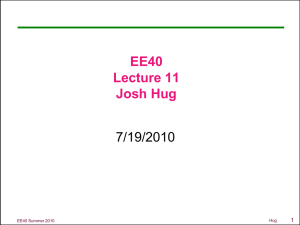lecture11_07_19_2010..
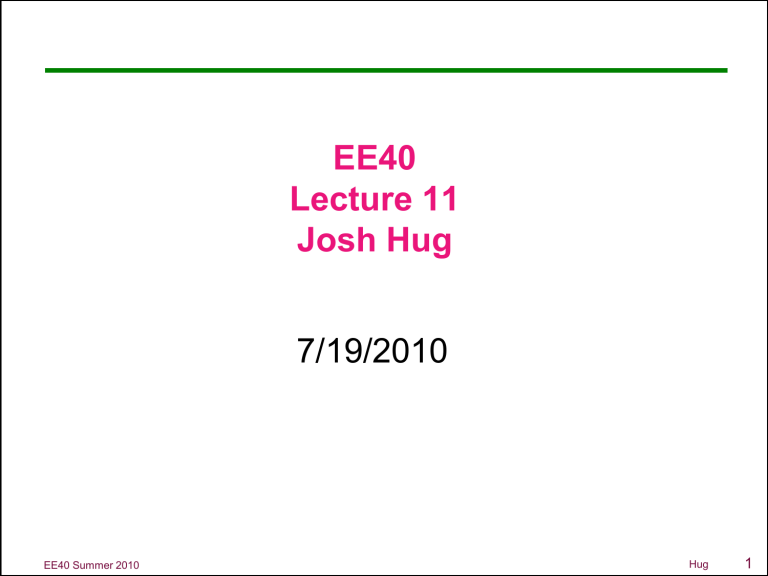
EE40 Summer 2010
EE40
Lecture 11
Josh Hug
7/19/2010
Hug 1
Logistical Things
• Lab 4 tomorrow
• Lab 5 (active filter lab) on Wednesday
– Prototype for future lab for EE40
– Prelab is very short, sorry.
– Please give us our feedback
– Google docs for labs and general class comments now available (link shared via email)
– Bring a music player if you have one (if not, you can use the signal generator in the lab)
• HW5 due tomorrow at 2PM
• HW6 due Friday at 5PM (also short)
• Midterm next Wednesday 7/28
– Focus is heavily on HW4, 5, 6, and Labs P1, 4, 5
– Will reuse concepts from HW 1,2,3
Hug EE40 Summer 2010
2
Logistics
• No lunch today
• Slightly shorter lecture today
• Midterm regrade requests due today
• Office hours Cory 240 2:30-4PM or so
EE40 Summer 2010 Hug 3
iClicker Question #1
• Consider a capacitor with a capacitance of
1𝑛𝐹 . Total resistance of circuit is small ~1Ω .
• If we compile an I-V table in lab with a voltage source and multimeter by:
– Applying a set of test voltages
– Measuring current through the capacitor for each source
• What I-V characteristic will we get?
– A. Horizontal line at I=0
– B. Vertical line at I=0
– C. Line of slope 1/RC
– D. Horizontal line at I=V/1Ω
– E. Something else
Hug 4
EE40 Summer 2010
iClicker Question #2
• Consider an inductor with an inductance of
1μ H. Total resistance of circuit is small ~1Ω .
• If we compile an I-V table in lab with a voltage source and multimeter by:
– Applying a set of test voltages
– Measuring current through the inductor for each source
• What I-V characteristic will we get?
– A. Horizontal line at I=0
– B. Vertical line at I=0
– C. Line of slope R/L
– D. Line at I=V/1Ω
– E. Something else
Hug 5
EE40 Summer 2010
Easy Method for AC Circuits
• We want to find the voltage across the capacitor for the following circuit
• Homogenous solution is easy, since source is irrelevant
• Finding particular solution the usual way
(plugging in a guess, finding coefficients that cancel) is painful
Hug 6
EE40 Summer 2010
Easy Method for AC Circuits 𝑣 𝑖
= 𝑉 𝑖 𝑒 𝑗𝑤𝑡
Guess 𝑣 𝑐𝑝
= 𝐴𝑐𝑜𝑠 𝜔
1 𝑡 + 𝜙
Plug into ODE
Solve for A and 𝜙 (hard) 𝑣 𝑐𝑝
= 𝐴𝑐𝑜𝑠 𝜔
1 𝑡 + 𝜙
EE40 Summer 2010
Guess 𝑉 𝑐𝑝
= 𝑘
1 𝑒 𝑗𝜔𝑡
Plug into ODE
Divide by 𝑒 𝑗𝜔𝑡
. Now 𝑡 is gone
Solve for 𝑘
1
(easy) 𝑣 𝑐𝑝
= 𝑅𝑒𝑎𝑙[𝑘
1 𝑒 𝑗𝜔𝑡 ]
Hug 7
Memory Circuits with Exponential Source
𝑉 𝑣
𝐼
′
𝑂
= 𝑉 𝑖 𝑒 𝑗𝑤𝑡
= −
𝑉
𝑂
𝑅𝐶 𝑡 > 0
+ 𝑉 𝑖 𝑒 𝑗𝜔𝑡
𝑅𝐶
• Homogeneous solution is just 𝐴𝑒 −𝑡/𝑅𝐶
• Pick particular solution 𝑒
𝑉 𝑗𝜔𝑡
𝑂,𝑃 𝑘
1 𝑗𝜔𝑒 𝑗𝜔𝑡 = −𝑘
1
+ 𝑉 𝑖
𝑅𝐶
= 𝑘 𝑒 𝑗𝜔𝑡
1
𝑅𝐶 𝑒 𝑗𝑤𝑡
, plug in:
• Divide by 𝑒 𝑗𝑤𝑡
, and solve for k
1 𝑘
1
1
= 𝑉 𝑖
1 + 𝑗𝜔𝑅𝐶
EE40 Summer 2010
𝑉
𝑂,𝑃 𝑡 = 𝑉 𝑖
1
1 + 𝑗𝜔𝑅𝐶 𝑒 𝑗𝑤𝑡
Real part of 𝑉
𝑂,𝑃 gives solution for cosine source
Hug 8
Inverse Superposition
• Superposition tells us that our output 𝑉
𝑂,𝑃 𝑡 be the sum of the effect of these two sources will just
𝑉
𝑂,𝑃
1 𝑡 = 𝑉 𝑖
1 + 𝑗𝜔𝑅𝐶 𝑒 𝑗𝑤𝑡
• Luckily for us, all complex numbers are the sum of their real and imaginary parts x = 𝑎 + 𝑗𝑏
• Just find real part and we’re done!
Hug 9
EE40 Summer 2010
Real Part of Expression
• Finding the real part of the expression is easy, it just involves some old school math that you’ve probably forgotten (HW5 has complex number exercises)
𝑉
𝑂,𝑃 𝑡 =
1
1 + 𝑗𝜔𝑅𝐶
𝑉 𝑖 𝑒 𝑗𝑤𝑡
• Key thing to remember is that complex numbers have two representations
– Rectangular form: 𝑎 + 𝑗𝑏
– Polar form: 𝑟𝑒 𝑗𝜃 𝑟 = 𝑎 2 + 𝑏 2 𝑏 𝜃 = arctan 𝑎
EE40 Summer 2010 Hug 10
Real Part of Expression
• What we have is basically the product of two complex numbers
• Let’s convert the left one to polar form
𝑉
𝑂,𝑃 𝑡 =
1
1 + 𝑗𝜔𝑅𝐶
𝑉 𝑖 𝑒 𝑗𝑤𝑡
– Rectangular form: 𝑎 + 𝑗𝑏
– Polar form: 𝑟𝑒 𝑗𝜃
𝑉
𝑂,𝑃 𝑡 =
1
𝑅𝑒 𝑗𝜙
𝑉 𝑖 𝑒 𝑗𝑤𝑡 = 𝑉 𝑖 𝑟 = 𝑎 2 + 𝑏 2 𝑏 𝜃 = arctan 𝑎
1
1 + 𝑤𝑅𝐶 2 𝑒 𝜙𝑗 𝑒 𝑗𝑤𝑡 𝜙 = arctan(𝜔𝑅𝐶)
Hug EE40 Summer 2010
11
Real Part of Expression
𝑉 𝑖
𝑉 𝑖
𝑉 𝑖
1
1 + 𝑤𝑅𝐶 2 𝑒 𝑗𝜙 𝑒 𝑗𝑤𝑡
1
1 + 𝑤𝑅𝐶 2 𝑒 𝑗(𝜙+𝜔𝑡)
1
1 + 𝑤𝑅𝐶 2
(cos 𝜔𝑡 + 𝜙 + 𝑗𝑠𝑖𝑛(𝜔𝑡 + 𝜙))
EE40 Summer 2010 Hug 12
Real Part of Expression
1
𝑉 𝑖
1 + 𝑤𝑅𝐶 2 𝑒 𝑗𝜙 𝑒 𝑗𝑤𝑡
• Superposition tells us that our output 𝑉
𝑂,𝑃 𝑡 be the sum of the effect of these two sources will just
𝑉
𝑂,𝑃 𝑡 =
𝑉 𝑖
1 + 𝑤𝑅𝐶 2
(cos 𝜔𝑡 + 𝜙 + 𝑗𝑠𝑖𝑛(𝜔𝑡 + 𝜙))
• Thus, particular solution (forced response) of
𝑉 original cosine source is just the real part
𝑂,𝑃
EE40 Summer 2010 𝑡 =
𝑉 𝑖
1 + 𝜔𝑅𝐶 2 cos 𝜔𝑡 + 𝜙 𝜙 = arctan(𝜔𝑅𝐶)
Hug 13
𝑣 𝑖
= 𝑉 𝑖 𝑒 𝑗𝑤𝑡
Easy Method for AC Circuits
Just as actually writing the ODE isn’t necessary for DC sources, we can avoid the ODE again in
AC circuits:
Impedance Analysis
Write ODE
Guess 𝑉 𝑐𝑝
= 𝑘
1 𝑒 𝑗𝜔𝑡
Plug into ODE
Divide by 𝑒 𝑗𝜔𝑡
. Now 𝑡 is gone
Solve for 𝑘
1
(easy) 𝑣 𝑐𝑝
= 𝑅𝑒𝑎𝑙[𝑘
1 𝑒 𝑗𝜔𝑡 ]
Hug 14
EE40 Summer 2010
Impedance 𝑣
𝐼
= 𝑉 𝑖 𝑒 𝑗𝜔𝑡 𝑡 > 0
For a complex exponential source:
1
𝑉
𝐶,𝑃 𝑡 =
1 + 𝑗𝜔𝑅𝐶 𝑣
𝐼
(𝑡)
Rewrite as:
𝑉
𝐶,𝑃 𝑡 =
1/𝑗𝑤𝐶
1/𝑗𝑤𝐶 + 𝑅 𝑣
𝐼
(𝑡)
Let 𝑍 𝑐
= 1/𝑗𝑤𝐶
𝑉
𝐶,𝑃 𝑡 =
𝑍 𝑐
𝑍 𝑐
+ 𝑅 𝑣
𝐼
(𝑡)
Looks a lot like… voltage divider
Real part gives solution for 𝑣
𝐼
= 𝑉 𝑖 cos(𝜔𝑡)
15
EE40 Summer 2010 Hug
Method of Impedance Analysis (without Phasors)
• Replace passive components with equivalent impedance, 𝑍 𝑐
=
1 𝑗𝜔𝐶
, 𝑍
𝐿
= 𝑗𝜔𝐿 , 𝑍
𝑅
= 𝑅
• Replace all sources with complex exponentials
• e.g. 𝑣 𝑡 = 𝐴 cos 𝜔𝑡 + 𝜃 ⟹ 𝑗(𝑤𝑡+𝜃)
• Solve using Ohm’s Law of Impedances for complex exponential sources
– Just like normal node voltage, but with complex numbers
– Real part of node voltage 𝑉 𝑎 𝑡 gives true output
𝑉 𝑎 𝑡
Lugging these complex exponential functions is algebraically annoying
Hug EE40 Summer 2010
16
Phasors (not in the book!)
• Definition: A phasor is a complex number which represents a sinusoid
• 𝑓 𝑡 = 𝐴𝑐𝑜𝑠 𝜔𝑡 + 𝜃
• Three parameters
– A: Magnitude
– 𝜔 : Frequency
– 𝜃: Phase
• The phasor representation of the sinusoid above is 𝐴𝑒 𝑗𝜃
• In shorthand we write phasor as 𝐴∠𝜃
Hug EE40 Summer 2010
17
Phasors
• If we have a voltage 𝑉 𝑡 = 𝐴𝑐𝑜𝑠 𝜔𝑡 + 𝜃
• The phasor version of the voltage is
𝑉 = 𝐴∠𝜃
• If we have a phasor 𝐼
= 𝛼∠𝜙 , the time function this phasor represents is 𝑖 𝑡 = 𝛼cos(𝜔𝑡 + 𝜙)
EE40 Summer 2010 Hug 18
Why are phasors useful?
• Sources that look like 𝐴𝑒 𝑡(𝑗𝜔+𝜃) result in lots of 𝐴𝑒 𝑡(𝑗𝑤+𝜃) terms in our algebra
• When you apply a sinusoidal source to a circuit, the amplitude and phase will vary across components, but it will always still be 𝛼𝑒 𝑡(𝑗𝜔+𝜙)
– Important: 𝜔 doesn’t change!
• Otherwise we’d need REALLY complex numbers
• Thus, we’ll just replace our sources with a complex number 𝐴∠𝜙 and just keep in mind that this number represents a function throughout
Hug 19
EE40 Summer 2010
Why are phasors useful?
• We know that for complex exponential sources, we have that:
– 𝑟𝑒𝑎𝑙 = 𝑟𝑒𝑎𝑙[ 𝑖 𝑡 𝑍]
• Phasors are complex numbers 𝑉 and
𝐼 which represent cosine functions 𝑣 𝑡 and 𝑖(𝑡)
• Cosine functions are just the real parts of complex exponentials
• Thus, in the world of phasors, we can just rewrite Ohm’s Law of Impedances as:
– = 𝐼𝑍
EE40 Summer 2010 Hug 20
Method of Impedance Analysis (with Phasors)
• Replace passive components with equivalent
1 impedance, 𝑍 𝑐
= 𝑗𝜔𝐶
, 𝑍
𝐿
= 𝑗𝜔𝐿 , 𝑍
𝑅
= 𝑅
• Replace all sources with phasor representation: e.g. 𝑣 𝑡 = 𝐴 cos 𝜔𝑡 + 𝜃 ⟹
• Solve using Ohm’s Law of Impedances:
– Just like normal node voltage, but with complex numbers, attaining voltage phasors 𝑉 𝑎
, 𝑉 𝑏
, …
– Output 𝑉 𝑎
(𝑡) is just | 𝑎
𝑉 𝑎
)
• Original sources are implicitly represented by phasors
– Time is gone completely from our problem
Hug EE40 Summer 2010
21
Example 𝑣
𝐼
= 𝑉 𝑖 𝑐𝑜𝑠 𝜔𝑡 ,
𝑅 = 10,000Ω
𝐶 = 1𝜇𝐹
𝑉 𝑖
= 5𝑉 𝜔 = 100
• 𝑍
𝑅
= 10000 , 𝑍
𝐶
1
= 𝑗𝜔𝐶
= −10000𝑗
𝑉 = 𝑉 𝑖
∠0 = 5∠0
• 𝑍 𝑒𝑞
= 10000 − 10000𝑗
5∠0
• 𝐼 =
10000−10000𝑗 𝑡 > 0
Find 𝑖(𝑡) in steady state
Hug EE40 Summer 2010
22
Example 𝑣
𝐼
= 𝑉 𝑖 𝑐𝑜𝑠 𝜔𝑡 ,
𝑅 = 10,000Ω
𝐶 = 1𝜇𝐹
𝑉 𝑖
= 5𝑉 𝜔 = 100 𝑡 > 0
Find 𝑖(𝑡) in steady state
5∠0
• 𝐼 =
10000−10000𝑗
• Polar divided by non polar, so convert bottom to polar
• 10000 − 10000𝑗 = 10000 2∠
−𝜋
4
Hug 23
EE40 Summer 2010
Example 𝑣
𝐼
= 𝑉 𝑖 𝑐𝑜𝑠 𝜔𝑡 ,
𝑅 = 10,000Ω
𝐶 = 1𝜇𝐹
𝑉 𝑖
= 5𝑉 𝜔 = 100
5∠0
• 𝐼 =
10000−10000𝑗
• 10000 − 10000𝑗 = 10000 2∠
−𝜋
4
• So 𝐼 = 5∠0
10000 2∠
−𝜋
4
=
1
2000 2
∠ 𝜋
4 𝑡 > 0
Find 𝑖(𝑡) in steady state
Hug 24
EE40 Summer 2010
Example 𝑣
𝐼
= 𝑉 𝑖 𝑐𝑜𝑠 𝜔𝑡 ,
𝑅 = 10,000Ω
𝐶 = 1𝜇𝐹
𝑉 𝑖
= 5𝑉 𝜔 = 100 𝑡 > 0
Find 𝑖(𝑡) in steady state
• 𝐼 =
1
2000 2
∠ 𝜋
4
• 𝑖 𝑡 =
1
2000 2 cos(100𝑡 + 𝜋
) [in steady state]
4
Hug 25
EE40 Summer 2010
EE40 Summer 2010
Example 𝑣
𝐼
= 𝑉 𝑖 𝑐𝑜𝑠 𝜔𝑡 , 𝑡 > 0 𝑖 𝑡 =
1
2000 2 cos(100𝑡 + 𝜋
)
4
• Current has same shape as voltage
• Current is 10000 2 times smaller than source voltage
• Current leads source voltage by 𝜋
4 radians or 𝜋 seconds
400
Hug 26 Not to scale
• On board
Harder Example
EE40 Summer 2010 Hug 27
Filters
• Often, we’ll want to build circuits which react differently based on different signal frequencies, e.g.
– Splitting audio signals into low and high portions (for delivery to tweeter and subwoofer)
– Removing noise of a particular frequency (e.g.
60 Hz noise or vuvuzela sound)
– Removing signals except those at a certain frequency
Hug 28
EE40 Summer 2010
Example Filter 𝑣
𝐼
= 𝑉 𝑖 𝑐𝑜𝑠 𝜔𝑡 ,
𝑅 = 10,000Ω
𝐶 = 1𝜇𝐹
𝑉 𝑖
= 5𝑉 𝑡 > 0
Find v c
(𝑡) in steady state
𝑉
𝐶
𝑉
𝐶
=
𝑍
𝐶
𝑍
𝐶
+𝑍
𝑅
𝑉
𝐼
=
−10
6 𝑗/𝜔
−10 6 𝑗/𝑤+10 5
𝑉
𝐼
𝑍
𝐶
= −10 6 𝑗/𝜔
𝑍
𝑅
= 10 5
𝑉
𝐶
=
1
1+0.1𝑗𝑤
𝑉
𝐼
- Transfer Function 𝑯(𝒋𝝎)
EE40 Summer 2010 Hug 29
Transfer Functions
𝑉
𝐶
=
1
1+0.1𝑗𝑤
𝑉
𝐼
= 𝐻(𝑗𝜔) 𝑉
𝐼
• Maps system input signal to system output signal
– Plug an input voltage A cos 𝜔𝑡 + 𝜙 into 𝑉
𝐼
– Get an output voltage 𝐴 𝐻 𝑗𝜔 cos 𝜔𝑡 + 𝜙 +
Hug 30
EE40 Summer 2010
Using a Transfer Function
𝑉
𝐶
=
1
1+0.1𝑗𝑤
𝑉
𝐼
= 𝐻(𝑗𝜔) 𝑉
𝐼
• Suppose 𝑣 𝑖
𝑉
𝐼
= 3∠ 𝜋
4
(𝑡) is 3 cos(50𝑡 + 𝜋
)
4
|𝐻 𝑗50 | = 1/ 26
∠𝐻 𝑗50 = −𝐴𝑟𝑐𝑇𝑎𝑛[5/1]
– 𝐻 𝑗50 =
1
1+5𝑗
= −1.37
• Output phasor 𝑉
𝐶
𝑉
𝐶
= is just 𝑉
𝐼
3
26
∠( 𝜋
4
− 1.37
)
× 𝐻 𝑗50
– 𝑣 𝑐 𝑡 =
3
26 cos(50𝑡 + 𝜋
4
− 1.37
)
Hug 31
EE40 Summer 2010
Using a Transfer Function (general)
𝑉
𝐶
=
1
1+0.1𝑗𝑤
𝑉
𝐼
= 𝐻(𝑗𝜔) 𝑉
𝐼
• Suppose 𝑣 𝑖
𝑉
𝐼
= 3∠ 𝜋
4
(𝑡) is 3 cos(𝜔𝑡 + 𝜋
)
4
|𝐻 𝑗𝑤 | = 1/ 1 + 0.01𝜔 2
∠𝐻 𝑗𝜔 = −𝐴𝑟𝑐𝑇𝑎𝑛[0.1𝜔/1]
– 𝐻 𝑗𝑤 =
1
1+0.1𝑗𝜔
• Output phasor 𝑉
𝐶 is just 𝑉
𝐼
× 𝐻 𝑗50
𝑉
𝐶
– 𝑣 𝑐
=
3
1+0.01𝜔 2
∠( 𝜋
4
− 𝐴𝑟𝑐𝑇𝑎𝑛 𝑡 =
0.1𝜔
1
)
3
1+0.01𝜔 2 cos(50𝑡 + 𝜋
4
− 𝐴𝑟𝑐𝑇𝑎𝑛[
0.1𝜔
1
] )
Hug 32
EE40 Summer 2010
Bode Magnitude Plot
𝑉
𝐶
=
1
1+0.1𝑗𝑤
𝑉
𝐼
= 𝐻(𝑗𝜔) 𝑉
𝐼
|𝐻 𝑗𝜔 | = 1/ 1 + 0.01𝜔 2
• Magnitude plot is just a plot of |𝐻 𝑗𝜔 | as a function of 𝜔
EE40 Summer 2010
Linear Scale Log Scale
Hug 33
Bode Magnitude Plot in Context of Circuit 𝑣
𝐼
= 𝑉 𝑖 𝑐𝑜𝑠 𝜔𝑡 ,
𝑉
𝐶
=
𝑅 = 10,000Ω
𝐶 = 1𝜇𝐹
𝑉 𝑖
= 5𝑉
1
1 + 0.1𝑗𝑤
𝑉
𝐼
= 𝐻(𝑗𝜔) 𝑉
𝐼 𝑡 > 0
|𝐻 𝑗𝜔 | = 1/ 1 + 0.01𝜔 2
All frequencies below 𝑤 𝑐
= 10 through pretty well. Above, that get increasingly attenuated
Hug 34
EE40 Summer 2010
Bode Phase Plot
𝑉
𝐶
=
1
1+0.1𝑗𝑤
𝑉
𝐼
= 𝐻(𝑗𝜔) 𝑉
𝐼
∠𝐻 𝑗𝜔 = −𝐴𝑟𝑐𝑇𝑎𝑛[0.1𝜔/1]
• Phase plot is just a plot of ∠𝐻 𝑗𝜔 as a function of 𝜔
EE40 Summer 2010
Linear Scale Semilog Scale
Hug 35
Bode Phase Plot in Context of Circuit 𝑣
𝐼
= 𝑉 𝑖 𝑐𝑜𝑠 𝜔𝑡 ,
𝑉
𝐶
=
𝑅 = 10,000Ω
𝐶 = 1𝜇𝐹
𝑉 𝑖
= 5𝑉
1
1 + 0.1𝑗𝑤
𝑉
𝐼
= 𝐻(𝑗𝜔) 𝑉
𝐼 𝑡 > 0
∠𝐻 𝑗𝜔 = −𝐴𝑟𝑐𝑇𝑎𝑛[0.1𝜔/1]
All frequencies below 𝑤 𝑐
= 10 move in time with the source, above that, 𝑣 𝑐 gets out of phase
Hug 36
EE40 Summer 2010
Frequency vs. Time Domain
• Almost always, our signals consist of multiple frequencies
• Examples:
– Sound made when you press a buttons on a phone is two pure sine waves added together
(DTMF)
– Antennas on radio theoretically pick up ALL frequencies of ALL transmissions
• Using a technique known as the Fourier
Transform, we can convert any signal into a sum of sinusoids
– See EE20 for more details
Hug EE40 Summer 2010
37
Fourier Transform Example
• If someone whistles a signal that is approximately sin(3000𝑡) , and we apply the Fourier Transform, then:
EE40 Summer 2010 Hug 38
Fourier Transform Example
• The 1 button on a phone is just 𝑣 𝑡 = sin
697
2𝜋 𝑡 + sin(
1209
2𝜋 𝑡)
EE40 Summer 2010 Hug 39
Fourier Transform Example
• If we apply a filter with the frequency response on the left to the signal on the right
Then we’ll get:
EE40 Summer 2010 Hug 40
Types of Filters
• Passive Filters
– Filters with no sources (i.e. just R, L, and C)
– Don’t require power source
– Scale to larger signals (no op-amp saturation)
– Cheap
• Active Filters
– Filters with active elements, e.g. op-amps
– More complex transfer function
• No need for inductors (can be large and expensive, hard to make in integrated circuits)
• More easily tunable
– Response more independent of load (buffering)
Hug EE40 Summer 2010
41
• On board
Filter Examples
EE40 Summer 2010 Hug 42
Manually Plotting
• In this day and age, it is rarely necessary to make our Bode plots manually
• However, learning how to do this will build your intuition for what a transfer function means
• Manual plotting of bode plots is essentially a set of tricks for manually plotting curves on a loglog axis
• We will only teach a subset of the full method (see EE20 for a more thorough treatment)
Hug 43
EE40 Summer 2010
Example Filter 𝑣
𝐼
= 𝑉 𝑖 𝑐𝑜𝑠 𝜔𝑡 ,
𝑅 = 10,000Ω
𝐶 = 1𝜇𝐹
𝑉 𝑖
= 5𝑉
𝑉
𝐶
=
1
1+0.1𝑗𝑤
𝑉
𝐼
1
𝑉
𝐶
=
1+0.01𝜔 2 ∠𝐴𝑟𝑐𝑇𝑎𝑛[0.1𝜔]
𝑉
𝐼
𝑉
𝐶
1
=
1+0.01𝜔 2
• Intuitive plot on board
𝑉
𝐼
• More thorough algorithm next time 𝑡 > 0
Find v c
(𝑡) in steady state
Hug 44
EE40 Summer 2010
Extra Slides
EE40 Summer 2010 Hug 45
Why do equivalent Impedances work?
• Components with memory just integrate or take the derivative of 𝑒 𝑞
1 𝑡
, giving scaled versions of the same function
– This is unlike forcing functions like 𝑡 3 or cos(𝜔𝑡)
– This allows us to divide by the source, eliminating 𝑡 from the problem completely
– Left with an algebra problem
– [For those of you who have done integral transforms, this whole process can be thought of as just using Laplace/Fourier transforms]
Hug 46
EE40 Summer 2010
